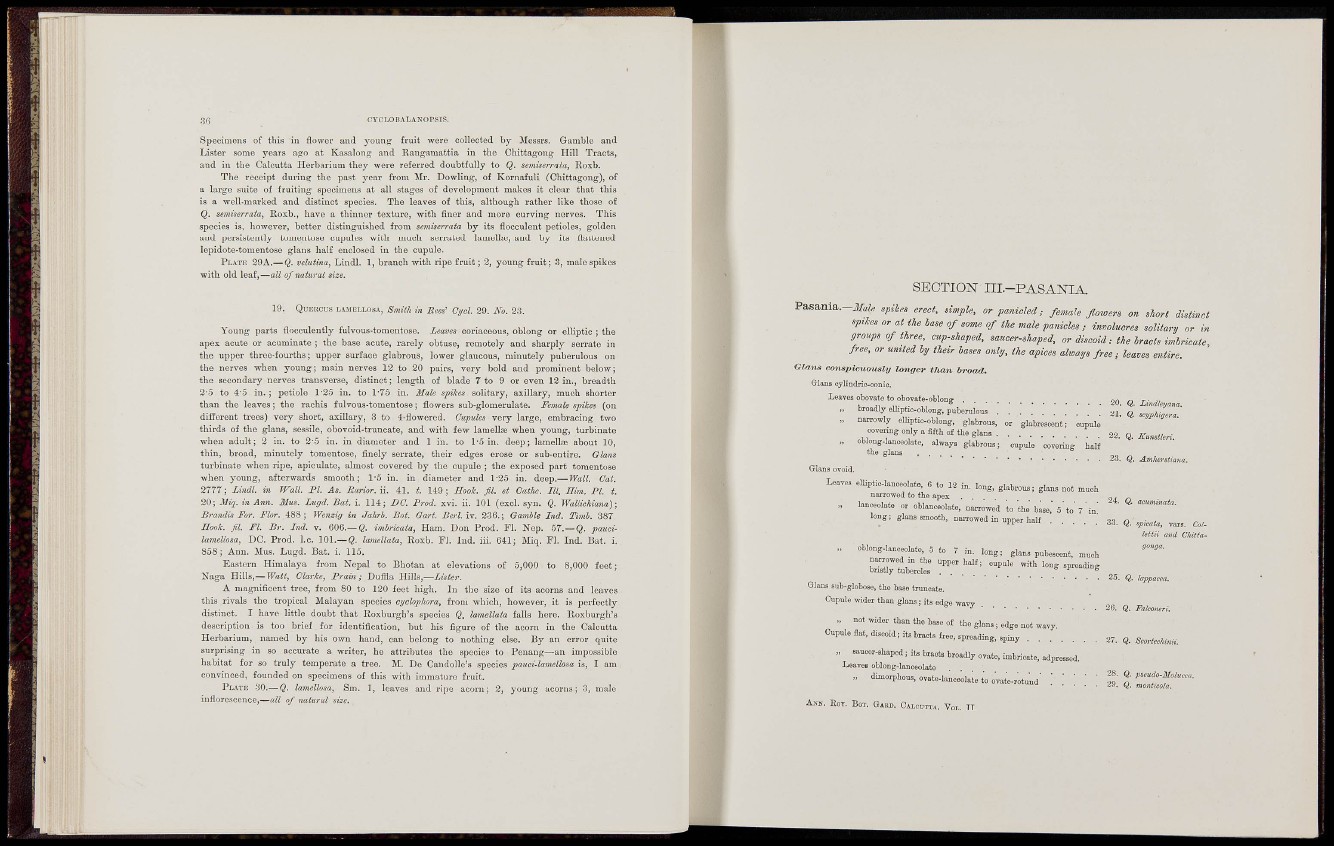
3ß CYCLO BAL ANOrsiS.
Specimens of this in flower and youn» fruit were collected by Messrs. Gamble and
Lister some years atro at Kasalong and Raugaiuattia in the Cbittagong Hill Tracts,
and in the Calcutta Herbarium they were referred doubtfully to Q. semiserrnta, Roxb.
The receipt during the past year from Mr. Dowling, of Kornafuli fChittagong), of
a large suite of fruiting specimens at all stages of development makes it clear that this
is a well-marked and distinct species. The leaves of this, although rather like those of
Q. semiserrata, Roxb., have a thinner texture, with finer and more curving nerves. This
species is, however, better distinguished from semiserrata by its flocculent petioles, golden
and persistently tomentose cupules with much serrated lamellfe, and by its flattened
lepidote-tomentose glans half enclosed in the cupule.
PLATE 29A.— Q. velutina, Lindl. 1, branch with ripe fruit; 2, young fruit; S, male spikes
with old loaf,—all of natural size.
19. QUERCUS LAMELLOSA, Smith in Sees' Cycl 29. No. 23.
Young parts flocculently fulvous-tomentose. Leaves coriaceous, oblong or elliptic ; the
apex acute or acuminate ; the base acute, rarely obtuse, remotely and sharply serrate in
the upper three-fourths; upper surface glabrous, lower glaucous, minutely puberulous on
the nerves when young; main nerves 12 to 20 pairs, very bold and prominent below;
the secondai-y nerves transverse, distinct; length of blade 7 to 9 or even 12 in., breadth
2 '5 to 4'5 in.; petiole 1'25 in. to 1'75 in. Male spikes solitary, axillary, much shorter
than the leaves ; the rachis fulvous-tomentose ; flowers sub-glomerulate. Female spikes (on
different trees) very short, axillary, 3 to 4-flowerod. Cupules very large, embracing two
thirds of the glans, sessile, obovoid-truncate, and with few lamella when young, turbinate
when adult; 2 in. to 2'5 in. in diameter and 1 in. to 1'5 in. deep; lamellai about 10,
thin, broad, minutely tomentose, finely serrate, their edges erose or sub-entire. Glans
turbinate when ripe, apiculate, almost covered by the cupule ; the exposed part tomentose
when young, afterwards smooth; 1-5 in. in diameter and 1-25 in. deep.— Wall. Cat.
2777; Lindl. in Wall. Fl. As. Raríor.ií. 41. t. 149; Hook. fit. et Cathc. III. Mim. PI. t.
20; Miq. in Ann. Mus. Lugd. Bat. i. 114; DC. Prod. xvi. ii. 101 (excl. syn. Q. WalHchiana)-,
Brandis For. Flor. 488; Wenzig in Jahrb. Bot. Gart. Beri. iv. 236.; GamUe Ind. Timh. 387
Hook. fil. Ft. Br. Ind. v. 606.—<2. imbrieata, Ham. Don Prod. FL Nep. Ò7.~Q. paucilamellosa,
DC. Prod. I.e. 101.— $ . lamellata, Roxb. Fl. Ind. iii. 641; Miq. Fl. Ind. Bat. i.
358; Ann. Mus. Lugd. Bat. i. 115.
Eastern Himalaya from Nepal to Bhotan at elevations of 5,000 to 8,000 feet;
Naga H i l l s ,—C l a r k e , Prain ; DufBa Hills,—Zwier.
A magnificent tree, from 80 to 120 feet high. In the size of its acorns and leaves
this rivals the tropical Malayan species cyclophora, from which, however, it is perfectly
distinct. I have little doubt that Roxburgh's species Q. lamellata falls here. Roxburgh's
description is too brief for identification, but his figure of the acorn in the Calcutta
Herbarium, named by bis own hand, can belong to nothing else. Ry an error quite
surprising in so accurate a writer, ho attributes the species to Penang—an impossible
habitat for so truly temperate a tree. M, Do Candolle's species pauci-lamellosa is, I am
convinced, founded on specimens of this with immature fruit.
PLATE 30.— Q. lamellosa, SM. 1, leaves and ripe acorn; 2, young acorns; 3, male
inflorescence,—all of natural size.
S E C T I O N ni.-PASANIA.
P a s a n i a . - i f A spike, erect, simple, or panielei ; female flower, on short disti,,et
up,ha or at tie hose of some of tie male paniolesmmlueres solitary or in
group, of three, euf-shaped, saucer-shaped, or discoid : the tracts imlrieate
free, or untied hj their base, only, tie ufices alway, free ; leaves entire.
Glans Gonsplcwusly Imigcr than broad.
Glana cylindrîo-conic.
Leaves oboYate to otovate-oblong go Q Undies ma
„ broadly elliptia-oblong, pubemlous . . . . '¿\ Ò i ' '
„ narro^rly eUiptio-oblong, gl.broM, or glabrescent; impulo ' '
o „ e r i „ g „ „ l y a à f t b o f a e g t o , 22 . 0
„ oblong-laaeeolale, alway, glabrous; cupole oowriog baH
the glans . . . .
Q. Amltevitiaua.
Glans ovoid.
Leaves emptiejaneeolato, 6 to 12 i, . lo„g, glab„„, glans not mncb
narrowed to the apes „, ^
„ lanceolate or obl.nceolate. n .„„ed to .be base,' s'to r'in' ^^ " " " " "
long; glans SMootb, narrowed io upper b.lf 33. ft .picata, vars. CIlettU
and Chitta-
„ oblong-lanceolato, 6 to 7 in. long; glans pubescent, n,„cb
Q. lappacea.
Glans sub-globose, the base truncate.
Cupule TOder than glans ; its edge wavv ^
Q. Falconeri.
not wider tbaa tbe b«,e of the glaus ; edge not ™vy.
Copule flat, discoid; itabrads tree, spreading, spiny 27. Q. ScH^M.H.
., sanccr-shaped ; it, W s broadly ovate, imbricate, adprcssed.
Leaves oblong-lanceolate
^^orpb.u,.v.tc.iance;ia;c;o„.ic..tund- ! : ! ! ! S
A-VK. KOV. BOT. Ginn. OALotim, VOL. II.